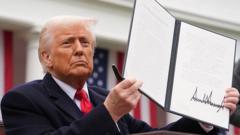One hundred and fifteen-thousand-dollar goods imported from Japan will now face a 15% tariff - a higher rate compared to the UK's 10% tariff, despite Japan's trade surplus. During negotiations, Japan exhibited surprising intensity, reflecting their position as the largest holder of U.S. Treasury bonds. The actions and rumors of hedge funds within Japan appear to have heightened concerns about the U.S. dollar's status, demanding attention to the importance of the situation.
This agreement also influences ongoing discussions with other economic powerhouses, particularly within the European Union. With Japan securing its agricultural imports while agreeing to import more U.S. rice, the future remains uncertain regarding the market acceptance of large American vehicles there.
Japan’s decision to move forward with the deal, despite potential waiting tactics, could be influenced by its Prime Minister’s domestic challenges. Other nations, including Indonesia and the Philippines, are also crafting similar agreements. In a world that seems to accept previously unimaginable tariffs on ally trading partners, Japan has avoided the anticipated 25% tariff that Trump threatened.
On the surface, the rise in U.S. tariff revenues appears significant, bringing in $100 billion so far this year. Although projected to exceed $300 billion annually, this revenue contrasts sharply with potential risks on U.S consumers who will inevitably foot the bill for higher prices due to these tariffs.
Furthermore, the broader economic implications are stark, as U.S. dollar value experiences a 10% decrease against a variety of currencies this year. This depreciation amplifies the costs of imports, contradicting earlier expectations from Treasury officials who had anticipated a stronger dollar minimizing effects. Global trends suggest a breaching of established patterns within the currency market, fostering speculations around the changing perceptions of the dollar, particularly against its main competitor, China.
In summation, this recent deal with Japan marks a compelling achievement for the current administration, helping to counter narratives of failure while raising additional questions about the long-term consequences of such tariff strategies on the global stage.
Stay tuned in as we cover these evolving financial discussions and strategies every week through our in-depth analysis.
This agreement also influences ongoing discussions with other economic powerhouses, particularly within the European Union. With Japan securing its agricultural imports while agreeing to import more U.S. rice, the future remains uncertain regarding the market acceptance of large American vehicles there.
Japan’s decision to move forward with the deal, despite potential waiting tactics, could be influenced by its Prime Minister’s domestic challenges. Other nations, including Indonesia and the Philippines, are also crafting similar agreements. In a world that seems to accept previously unimaginable tariffs on ally trading partners, Japan has avoided the anticipated 25% tariff that Trump threatened.
On the surface, the rise in U.S. tariff revenues appears significant, bringing in $100 billion so far this year. Although projected to exceed $300 billion annually, this revenue contrasts sharply with potential risks on U.S consumers who will inevitably foot the bill for higher prices due to these tariffs.
Furthermore, the broader economic implications are stark, as U.S. dollar value experiences a 10% decrease against a variety of currencies this year. This depreciation amplifies the costs of imports, contradicting earlier expectations from Treasury officials who had anticipated a stronger dollar minimizing effects. Global trends suggest a breaching of established patterns within the currency market, fostering speculations around the changing perceptions of the dollar, particularly against its main competitor, China.
In summation, this recent deal with Japan marks a compelling achievement for the current administration, helping to counter narratives of failure while raising additional questions about the long-term consequences of such tariff strategies on the global stage.
Stay tuned in as we cover these evolving financial discussions and strategies every week through our in-depth analysis.






















